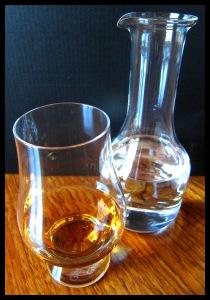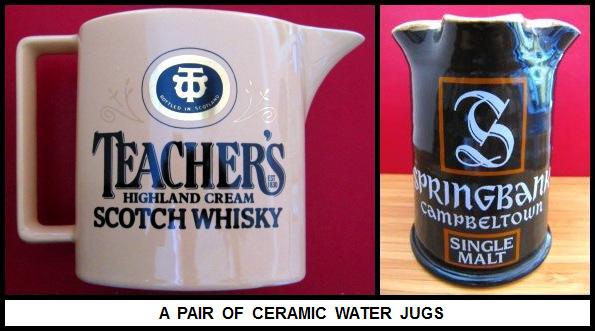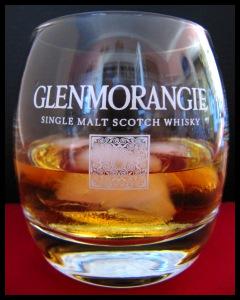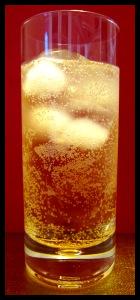A Rich Pour 26: Water & Whisky – An Uneasy Alliance

Monday October 27, 2014
Water and whisky can make for difficult partners – never mind the fact that the word whisky derives from the Scottish Gaelic uisge beatha, meaning ‘water of life’.
You’d think the two would be inseparable. After all, how many times are the virtues of a distillery’s water supply extolled by enterprising marketing agents? Be it Loch Luminous, Bright’s Burn or Waydown’s Well, some whisky industry spokesperson is sure to exclaim, “Ah yes, there’s a magical quality to our water.” Who knows? The distillery probably even hired a man with a divining rod to search out the source. All of this hyperbole hails from the B.S. (before sales) era, of course.

Nevertheless, be it a cask strength or standard strength release, whisky in the bottle contains water – sometimes less, sometimes more, but always. And the quality of the water is most assuredly up to snuff. Why is it, then, that the question of whether or not to add a little more water to a dram of whisky incites discussions as heated as freshly harvested habañeros? No dilution on this topic, apparently.
The drink every whisky as it pours camp, I’m convinced, is largely comprised of fire-breathing dragons and purists, while the water always works camp seems to be made up of tender tongues, professional nosers and, yes, purists. With purists standing on both sides of the divide and everyone else off in one corner or another, no wonder there’s such a degree of confusion concerning the matter of water and whisky. It’s a veritable whirlpool.

I would appear to have a foot firmly planted in both groups – an awkward position, to be sure, but one not entirely without merit. Why? Simply because I find that some whiskies ‘love’ water and others don’t. To increase the ambivalence factor even more, I’ve discovered over the years that my dilutional preferences can change from one drinking occasion to the next. Is there anything wrong with that? Not one bit.
When I visited Oban Distillery in Scotland, John, the day’s guide, enlisted me in a little experiment. Perhaps he was getting back at me for my having asked one too many questions during the tour. We both had smiles on our blog, regardless.
The whisky in my hand was, naturally enough, Oban 14 Year Old – a standard strength, 43% alcohol by volume spirit. I’d already gone through more than my fair share of this malt over the years. There was little chance of my being surprised, or so I thought.
John asked me to describe the aroma and taste of the Oban as poured from the bottle. No problem there. I quickly rattled off a series of detailed descriptors, half drawn from memory and half improvised on the spur of the moment.
Then, he dexterously dropped a smidgen of water into the centre of my glass and coaxed me to offer my immediate impressions. Something strange had indeed taken place. It was almost as though the whisky had exploded. Certain scents and tastes seemed as sharp as nails. I was amazed.
Lastly, John requested I roll the now watered down Oban around the inside of the glass, and relate my final thoughts. This was a different whisky from that which had first been poured. The spirit had retained its essential characteristics, but the degree of complexity had broadened and the softness had increased. Lesson learned.

Now, there’s more than one way to water a whisky. And while outright dilution has its benefits and its diehard fans, one always runs the risk of going too far and destroying the spirited liveliness of the liquor. It’s not about calling in the Fire Department, after all.
In the case of most standard strength whiskies, a little water goes a long way. For this reason, I usually prefer (unless I’m conducting an in-depth tasting) to take a small sip and let the spirit mingle on the palate with my saliva. John at Oban might disagree, but I’ll stick to my shot glasses on this one. Besides, I can always change my mind later and go for the eau.
When it comes to high proof or cask strength whiskies, caution is a ‘best friend’. At more (sometimes considerably more) than 50% alcohol by volume, these spirits can be real ‘blow torches’ as they pour. However, forget about blindly rendering these sorts of spirits, through the addition of water, to a standard strength. Some whiskies may accept this sort of treatment in style. Others, though, will simply fall apart in the glass. It’s obviously a bit of a crap-shoot, and not just a simple equation.
Drop by drop and re-taste it is, then. You’ll know when you’ve arrived at a sage stage of dilution. The alcoholic burn will be tolerable, minimal or non-existent, yet the aromas and flavours will still appear vigorous, clear and focused. It also helps to keep a glass of still water on the side for palate regeneration purposes.

One more point… Your dog may like to lap water from puddles and ponds. That doesn’t mean you will. So only use good quality water to add to your whisky. Tap water can be problematic. But filtered water, denatured or distilled water, or a reputable brand of bottled spring water works just fine. If you happen to have access to some pure well water or clear, unprocessed spring water far removed from any potential sources of pollution, even better.
I think I’ll ask if I can hire that man with the divining rod. On second thought, he’ll probably charge me the price of a cask of whisky and not offer me a guarantee in the bargain. Difficult partners, indeed.
Referenced articles and books
Broom, Dave, Yes, You Can Add Water to Whisky, Whisky Advocate, Volume 21, Number 2, Summer 2012, M. Shanken Communications Inc., N.Y., N.Y., U.S.A., pp. 66, 68, 70
Chartier, François, Taste Buds and Molecules: The Art and Science of Food with Wine, translated by Levi Reiss, McClelland & Stewart, Toronto, Canada, 2010, pp. 35-36
De Kergommeaux, Davin, Canadian Whisky: The Portable Expert, McClelland & Stewart Limited., Toronto, Canada, 2012, pp. 75-83
Jackson, Michael, Michael Jackson’s Malt Whisky Companion, Sixth Fully Revised Edition, Updated by Dominic Roskow, Gavin D. Smith and William C. Meyers, Dorling Kindersley Limited, London, England 2010, pp. 33-34
Kuebler, Doug, The Tumbler’s Guide to Single Malt Scotch Whisky: Armchair Reference Manual, Topeda Hill Publishing, Baldwin Mills, Québec, Canada, ©2003 Doug Kuebler & Topeda Hill Publishing, p.15
MacLean, Charles, Whiskypedia: A Compendium of Scottish Whisky, Skyhorse Publishing, New York, N.Y. 2010, pp. 29-30,
Risen, Clay, American Whiskey: A Guide to the Nation’s Favorite Spirit, Sterling Epicure, N.Y., N.Y., U.S.A., 2013, pp. 64-68

I would be remiss, when discussing the mixing of whisky and water, to not mention one of the most famous combinations of these two liquids – whisky and soda. The effervescence of soda water brings, along with a considerable degree of dilution, a refreshing, sparkling flavour dimension to this classic cocktail.
Of course, I’d likely resist adding soda water to an expensive, hard to replace malt whisky, given that the spirit is bound to end up playing second fiddle to those bubbles. On the other hand, any decent blended whisky (or modestly priced malt) can provide the perfect foundation for a few cubes of ice and a top-up of soda. The traditional lemon wedge garnish is optional.
An interesting variation on whisky and soda is the floater, which dispenses with ice cubes and sees the whisky gently layered atop the soda water rather than stirred in.
Cheers!
__________________________________________________
Doug Kuebler (jazznut) is an inveterate aficionado and collector of wines and whiskies. Apart from organizing wine and food seminars, Doug has also written extensively on wines and liquors over the last three decades. His first published book-set, The Tumbler's Guide to Single Malt Scotch Whisky, has been well-received in North America, the British Isles and Asia.



